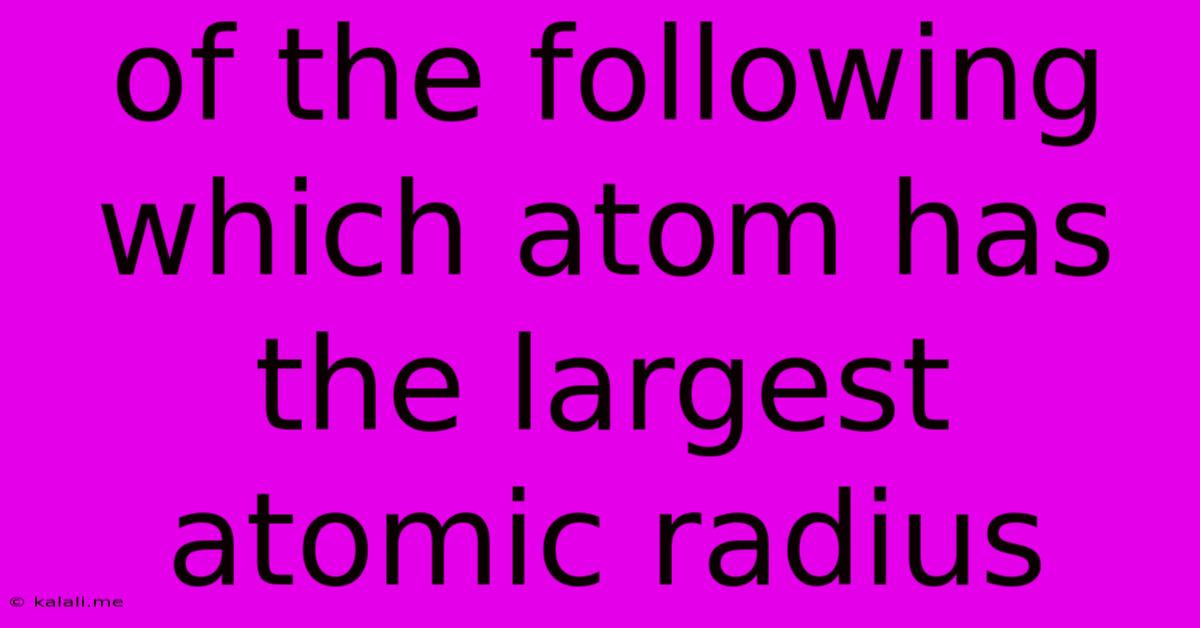Of The Following Which Atom Has The Largest Atomic Radius
Kalali
Jun 15, 2025 · 3 min read

Table of Contents
Which Atom Has the Largest Atomic Radius? Understanding Atomic Size Trends
Determining which atom possesses the largest atomic radius requires understanding the periodic trends influencing atomic size. This article will explore these trends and identify the atom with the largest atomic radius among common elements. We'll examine factors like electron shielding, effective nuclear charge, and energy levels to provide a comprehensive explanation.
Understanding Atomic Radius:
Atomic radius refers to the distance from the atom's nucleus to its outermost electron shell. It's not a fixed value because electron clouds are probabilistic, but it's a useful concept for comparing the relative sizes of atoms. Several factors influence an atom's radius:
-
Energy Levels (Principal Quantum Number, n): As you move down a group (column) in the periodic table, the number of electron shells increases. Each additional shell adds distance from the nucleus, thus increasing the atomic radius.
-
Effective Nuclear Charge: This represents the net positive charge experienced by an electron. A higher effective nuclear charge pulls electrons closer to the nucleus, reducing the atomic radius. Shielding from inner electrons reduces the effective nuclear charge felt by outer electrons.
-
Shielding Effect: Inner electrons shield outer electrons from the full positive charge of the nucleus. The more inner electrons, the weaker the attraction between the nucleus and outer electrons, leading to a larger atomic radius.
-
Electron-Electron Repulsion: Electrons repel each other. In larger atoms with more electrons, this repulsion can slightly expand the electron cloud, increasing the atomic radius.
Periodic Trends and Atomic Radius:
The periodic table provides a roadmap for understanding atomic size. Generally:
-
Across a Period (Row): Atomic radius decreases from left to right. This is because the number of protons increases, increasing the effective nuclear charge, pulling electrons closer to the nucleus. While more electrons are added, they are added to the same energy level, and the increased nuclear charge dominates.
-
Down a Group (Column): Atomic radius increases from top to bottom. This is due to the addition of electron shells, increasing the distance between the nucleus and the outermost electrons. The increase in shielding outweighs the increase in nuclear charge.
Identifying the Atom with the Largest Atomic Radius:
While there isn't a single definitive "largest" atom because the size of atoms is constantly debated, and some elements are unstable and hard to measure, among the commonly studied elements, Francium (Fr) generally holds the title. Francium is located at the bottom of Group 1 (alkali metals) and has the highest principal quantum number (n) among stable elements. Its high number of electron shells and relatively weak effective nuclear charge contribute to its large atomic radius. Cesium (Cs), directly above it, also has a very large atomic radius.
Conclusion:
Understanding the factors influencing atomic radius – energy levels, effective nuclear charge, and shielding – is crucial for predicting the relative sizes of atoms. While theoretical calculations can provide precise measurements, the general trends within the periodic table allow us to understand why Francium, with its many electron shells, boasts one of the largest atomic radii among readily available elements. Remember, the specific measurements can vary slightly depending on the method used, but the overall trend remains consistent.
Latest Posts
Latest Posts
-
Which Of The Following Is Not A Hypothesis
Jun 15, 2025
-
What Is The Modulus Of Elasticity For Steel
Jun 15, 2025
-
What Is The Lcm Of 14 And 20
Jun 15, 2025
-
Which Biome Is Characterized By Permafrost
Jun 15, 2025
-
All Of The Following Are Components Of Ecf Except
Jun 15, 2025
Related Post
Thank you for visiting our website which covers about Of The Following Which Atom Has The Largest Atomic Radius . We hope the information provided has been useful to you. Feel free to contact us if you have any questions or need further assistance. See you next time and don't miss to bookmark.